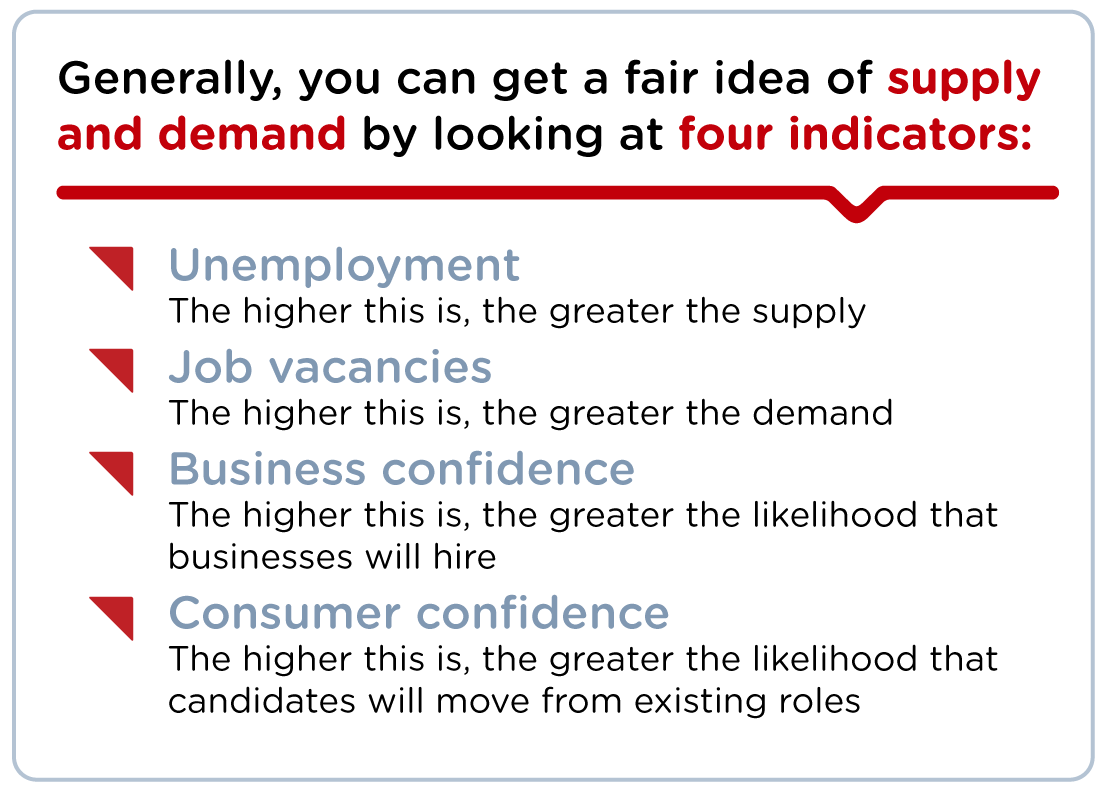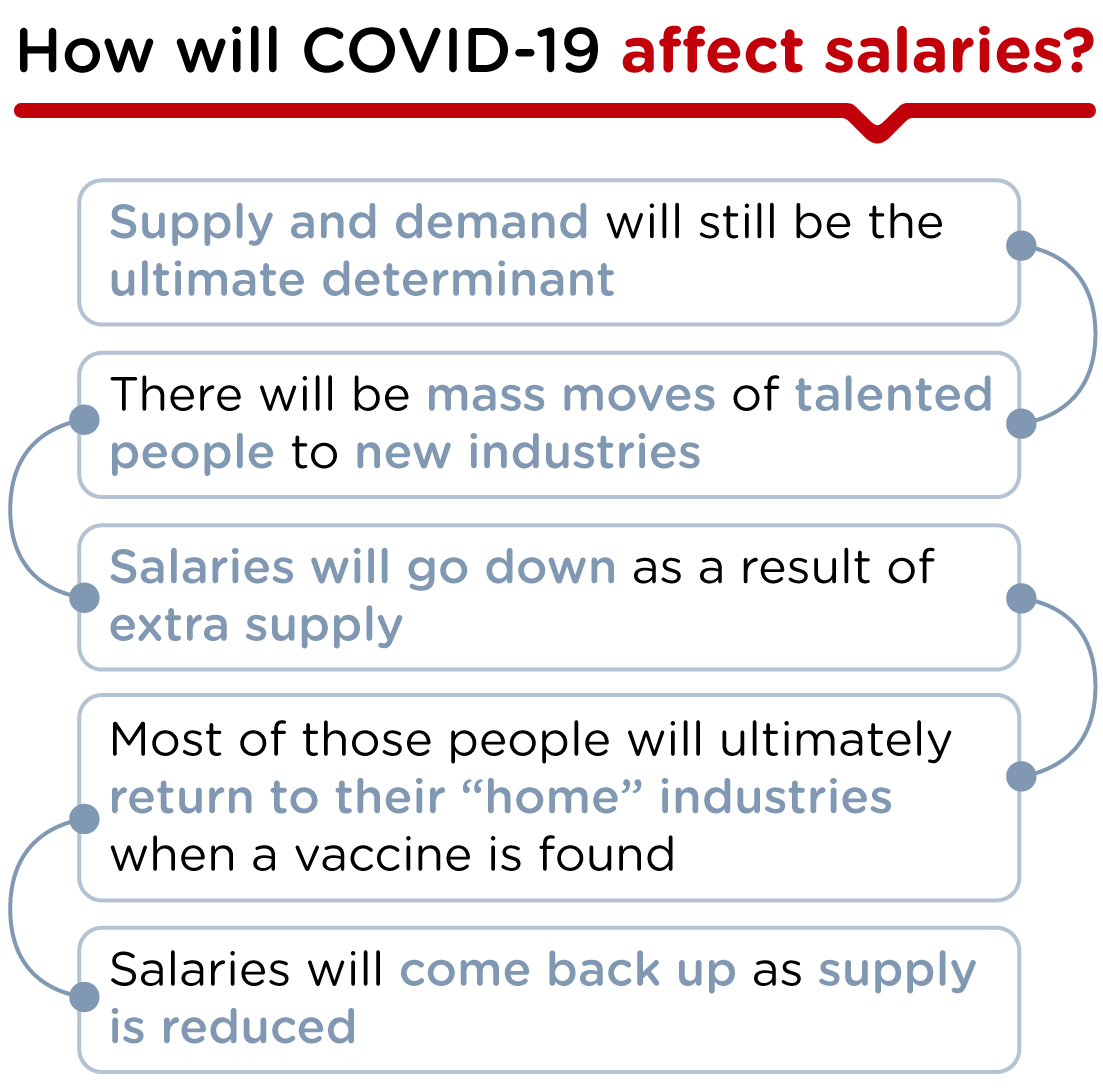Setting Salaries in a Shifting Market: Hiring During COVID-19
Salary levels: Whilst high unemployment environments are associated with lower salaries, it is unlikely this will be the case across the board. Companies who offer lower salaries will fill those roles, but the employee will continue to job hunt and will move when a better offer comes along.
Frontline Recruitment Group works across a number of industries and almost all placements made by Frontline are for permanent positions with an agreed salary, not wages – it helps to understand the difference. According to Employsure, an HR advisory firm in AUS and NZ, a wage is a rate of pay commonly affixed to a period of time, such as per hour, or per day. A salary is a fixed, regular payment agreed upon in an employment contract, however, it is not affixed to the number of hours performed. This article is focussed on how salaries will be impacted by COVID-19.
Supply and Demand
Salaries are about supply and demand, rather than how much you are prepared to pay someone. Of course, people will work for salaries that do not reflect supply and demand, but if you pay below the market average without doing anything to address the gap, the employee will be looking for another role and will probably jump ship the first chance they get. They may even resent your brand, and will be unlikely to go the extra mile. However, if you are paying more, you increase the chances of retention, brand allegiance and dedication to the job. The trick is identifying what the market salary level is!
The problem with COVID-19 is that supply and demand are more complicated than just the indicators above. Wage and salary subsidies in both AU and NZ are masking real unemployment. Job vacancies are dependent upon job board contracts that have resulted in agencies and companies just advertising in order to use their quotas during COVID-19. Both business and consumer confidence is being propped up by government assistance programmes and the great job done by the AUS and NZ governments in managing the first wave of COVID-19. So, at best, the figures are skewed.
Specific industries such as Travel, Tourism and Hospitality have been negatively affected, and others, such as Health, IT and Delivery Services have been impacted positively. Middle management and support services such as in-house trainers, recruiters and marketers have been or will be let go when wages subsidies cease, so there are industry and occupational forces at play.
It could be argued that the COVID-19 restrictions have polarised the workforces of AUS and NZ and created the “haves” and the “have nots.” There is much greater demand in some industries and much less in others, and at some stage, this will result in salary disparities between those industries and occupations.
We expect there will be a big movement of talented people from those industries that are most affected, almost like a wave going out at the beach. Then, when a vaccine is found, there will be a reverse move as Travel, Tourism and Hospitality get going again – and the wave will come crashing back in!
This will not be like what we have seen in the past where an industry is reduced over time, never to recover, such as the car manufacturing industry, which could not compete with lower overseas wages and better technology. No, COVID-19 will create two waves of change. One where workers from the most affected industries look to other industries for work, and the other when those same workers will return in droves to their original industry when a vaccine is found and things “return to normal.”
How to Set Salaries in an Uncertain Market
For employers, determining salaries in this type of market is going to be tricky. Supply and demand will change very quickly, and salaries will come under pressure much faster than they have in the past – a good salary this quarter may be a low salary next quarter.
The best way to deal with this will be to shorten salary review timeframes and realise that the highly talented employee you managed to hire from the Travel industry last week may not be the long-term hire you had hoped they were. So, if you do want to keep them, then you will need to be aware of not only what salary they can demand now in your industry, but what they can demand later in their previous industry when that recovers.
Getting salaries right over the next few years is not going to be easy, there are going to be more factors than are usually at play. The starting point is just being aware that as subsidies are withdrawn, unemployment fluctuates, and industries recede and recover, supply and demand will fluctuate and so will salaries.
It will be no good to look at last year’s salary surveys – the market will move much too fast for that, and unemployment, job vacancy, business and consumer confidence figures lag at least six weeks behind the market.
The best thing to do is to find a good specialist recruiter you trust – who knows your industry and works in it at the coal face every day – and talk with them often, as they are best placed to give you the advice. Ask them what is happening with salaries right now, what supply and demand are like in your sector and region, and seek their opinion on what will happen in the next three months. If you are making an offer to a candidate, this information will help you when determining what is a fair salary.
If you’re looking for salary advice or need help recruiting for your team in this unique business environment, feel free to reach out – and don’t forget to review my summary of the other key challenges employers must deal with amid COVID-19, here.
Pete Davis is Managing Director of Frontline Recruitment Group (FRG). FRG is a specialist recruitment company with offices across Australia and New Zealand – they have been operating since the early 1990s and have worked in high unemployment environments with job hunters in many different industries. This blog series is about sharing some of the lessons from the past and integrating them with the technology and business practices of today. We hope you enjoy these articles and welcome your opinions.
Read more


